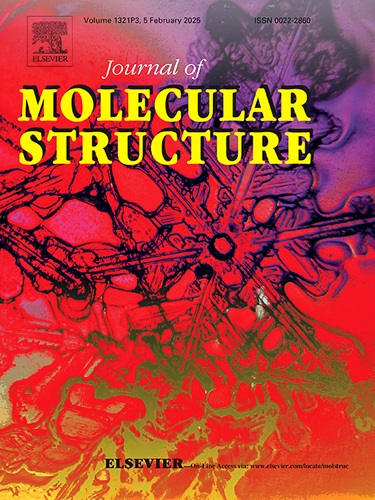Synthesis, spectral, crystal structure, linear and NLO properties of quinoline Schiff base: Combined experimental and DFT calculations
IF 4
2区 化学
Q2 CHEMISTRY, PHYSICAL
引用次数: 0
Abstract
The study explores the optical and nonlinear optical (NLO) properties of 2-imino [N- (N'-amido phenyl)] chromophore, a compound with potential in photonic applications. The compound was produced and crystallized using a slow evaporation approach using ethanol as solvent, and spectroscopy techniques were used to characterize it. The molecular structure of the compound was determined using FT-IR and NMR spectral methods. The crystal's structure was found via SCXRD analysis, showing a monoclinic system with a P21/c space group. The UV–Vis-NIR spectrum showed good transmittance over the visible region, with lower cutoff wavelengths of 338 nm and optical band gaps of 3.17 eV. The grown crystal exhibited a χ3 value of 2.89 × 10−8esu, making it valuable for non-linear optical applications. Quantum computational analysis was used to investigate molecular architectures, topologies, and molecule-level third-order NLO response. The compound exhibited a planar molecular geometry, with an average third-order NLO polarizability of 69.65 × 10−36 esu. The study also examined quantum chemically computed UV–visible spectra and electron density difference maps, as well as the density of states and molecular electrostatic potentials. In addition to highlighting the relationship between structure and characteristics, our current study of synthesized compounds highlights the potential of photonic applications.
喹啉席夫碱的合成、光谱、晶体结构、线性和 NLO 特性:实验与 DFT 计算相结合
该研究探讨了 2-亚氨基[N-(N'-氨基苯基)]发色团的光学和非线性光学(NLO)特性,这是一种具有光子应用潜力的化合物。该化合物是以乙醇为溶剂,通过缓慢蒸发的方法制得并结晶的,并利用光谱技术对其进行了表征。利用傅立叶变换红外光谱和核磁共振光谱方法确定了该化合物的分子结构。通过 SCXRD 分析发现了该化合物的晶体结构,显示其为单斜体系,空间群为 P21/c。紫外-可见-近红外光谱在可见光区域显示出良好的透射率,较低的截止波长为 338 nm,光带隙为 3.17 eV。生长出的晶体的 χ3 值为 2.89 × 10-8esu,使其具有非线性光学应用价值。量子计算分析用于研究分子结构、拓扑和分子级三阶非线性光学响应。该化合物呈现出平面分子几何结构,平均三阶 NLO 极化率为 69.65 × 10-36 esu。研究还考察了量子化学计算的紫外-可见光谱和电子密度差图,以及状态密度和分子静电势。除了强调结构与特性之间的关系外,我们目前对合成化合物的研究还凸显了光子应用的潜力。
本文章由计算机程序翻译,如有差异,请以英文原文为准。
求助全文
约1分钟内获得全文
求助全文
来源期刊

Journal of Molecular Structure
化学-物理化学
CiteScore
7.10
自引率
15.80%
发文量
2384
审稿时长
45 days
期刊介绍:
The Journal of Molecular Structure is dedicated to the publication of full-length articles and review papers, providing important new structural information on all types of chemical species including:
• Stable and unstable molecules in all types of environments (vapour, molecular beam, liquid, solution, liquid crystal, solid state, matrix-isolated, surface-absorbed etc.)
• Chemical intermediates
• Molecules in excited states
• Biological molecules
• Polymers.
The methods used may include any combination of spectroscopic and non-spectroscopic techniques, for example:
• Infrared spectroscopy (mid, far, near)
• Raman spectroscopy and non-linear Raman methods (CARS, etc.)
• Electronic absorption spectroscopy
• Optical rotatory dispersion and circular dichroism
• Fluorescence and phosphorescence techniques
• Electron spectroscopies (PES, XPS), EXAFS, etc.
• Microwave spectroscopy
• Electron diffraction
• NMR and ESR spectroscopies
• Mössbauer spectroscopy
• X-ray crystallography
• Charge Density Analyses
• Computational Studies (supplementing experimental methods)
We encourage publications combining theoretical and experimental approaches. The structural insights gained by the studies should be correlated with the properties, activity and/ or reactivity of the molecule under investigation and the relevance of this molecule and its implications should be discussed.
 求助内容:
求助内容: 应助结果提醒方式:
应助结果提醒方式:


